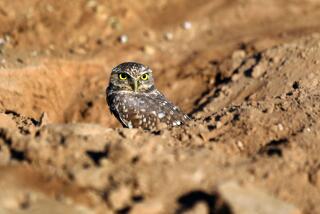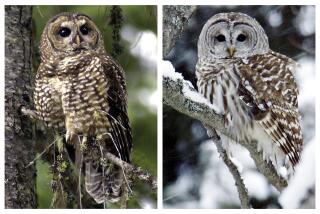BREEDING BIRDS: GREAT HORNED OWL : GREAT HORNED OWL : (Bubo virginianus)
- Share via
Description: This largest of Orange County’s breeding owls is distinguished by its bulky shape, white throat and ear tufts.
Habitat: Coniferous or deciduous forest and woodland, swamp, orchard, park, riparian forest and semidesert.
Diet: Small mammals, especially rabbits and rodents, and birds, including pheasants, quail, passerines (perching birds). Will occasionally eat fish, amphibians, reptiles, scorpions.
Displays: Male performs noisy aerial courtship display, ritually feeds female. Pair bill, bob, call and click.
Nest: In abandoned tree nest of raptor or raven; also tree cavity, cave, crevice, stump and on ground in log or among rocks. Nests made of sticks, moss, hair, shredded bark, rootlets, etc., and lined slightly with feathers and down.
Eggs: Dull white, slightly more than 2 inches long.
Natural history notes: A common bird in suburban areas. Chiefly nocturnal, the great horned owl--like other owls--has fluffy plumage that makes its flight nearly soundless.
Note: Map is divided into 5-kilometer squares so that Audubon Society volunteers can more easily survey areas on a regular basis.
Sources: Sea and Sage Audubon Society; “The Birder’s Handbook,” Ehrlich, Dobkin and Wheye, Fireside Books (1988); “Field Guide to the Birds of North America,” National Geographic Society (1987); “Birds of Southern California: Status and Distribution,” Garrett and Dunn, Los Angeles Audubon Society (1981).
Indicates 5-kilometer-square areas where breeding activity has been confirmed.
DR, RUSS ARASMITH
More to Read
Sign up for Essential California
The most important California stories and recommendations in your inbox every morning.
You may occasionally receive promotional content from the Los Angeles Times.









